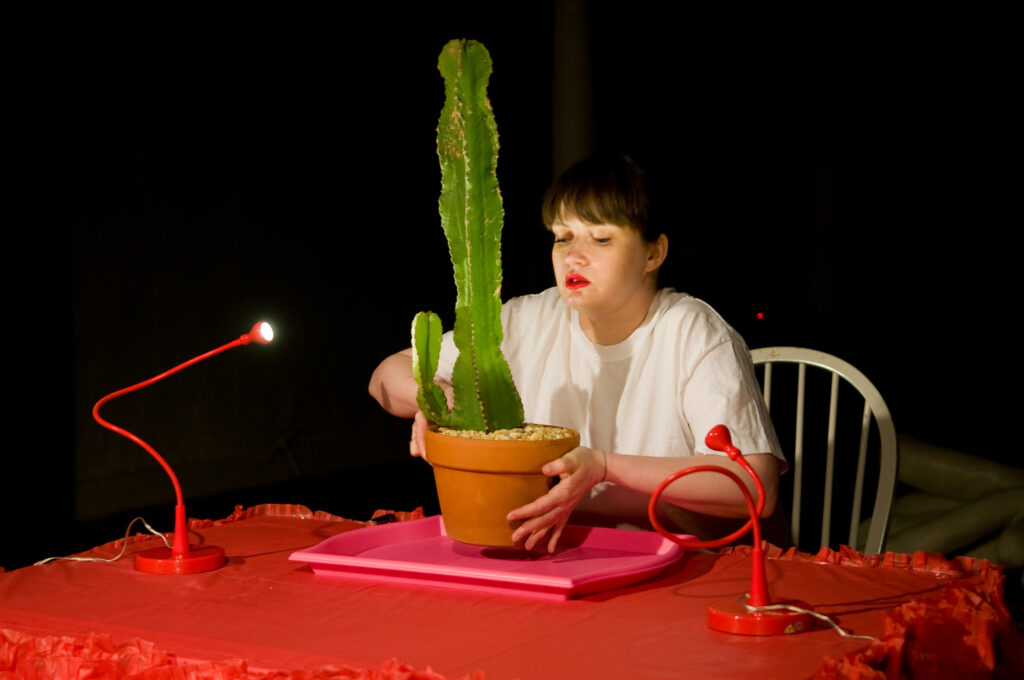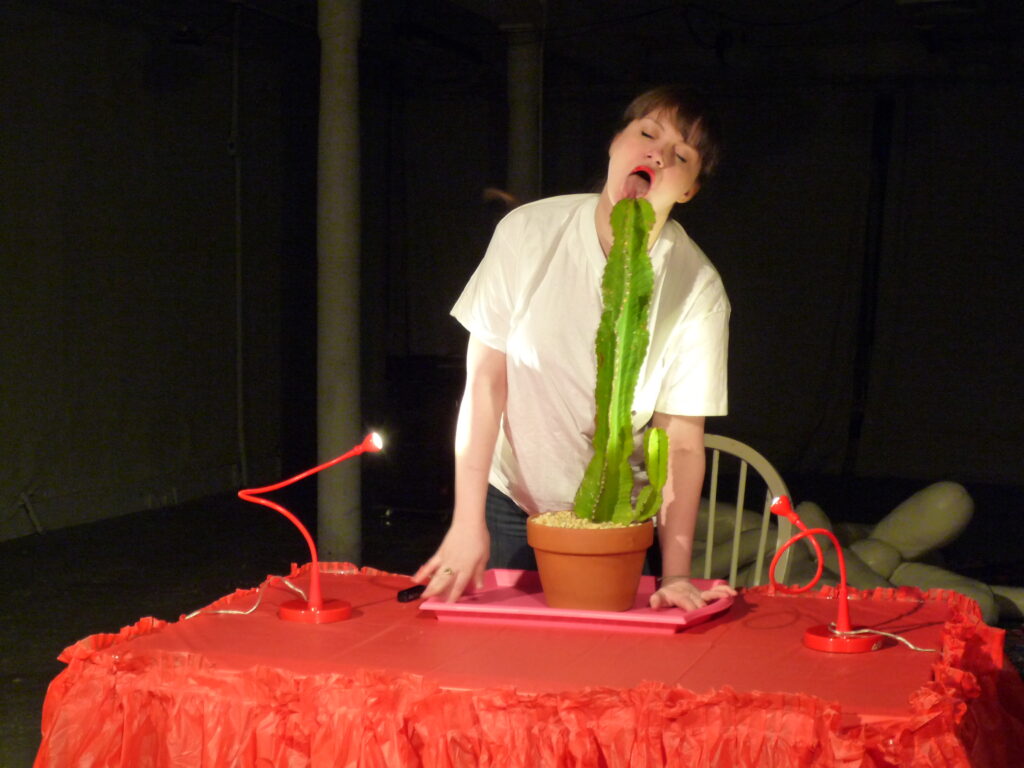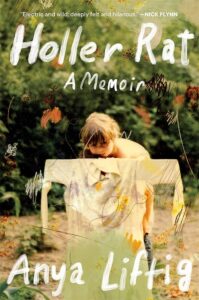
Anya Liftig’s debut memoir Holler Rat is one of stunning juxtapositions. She takes readers from her Mawmaw’s family homestead in Appalachian Kentucky to her freshman year dorm at Yale. We travel from the mansions of Westchester, where Liftig tutored rich kids, to a pre-gentrified Bushwick loft, where toilet water leaked from the ceiling and onto her bed. The result is an unflinching exploration of an identity that straddles class worlds.
Liftig also weaves anecdotes about her award-winning performance artwork throughout. Her performance art is also one of juxtapositions, as she lures the viewer in with humor, and then swerves into shocking brutality. In one chapter, Liftig makes out with a salmon she got from a Brooklyn butcher, then proceeds to blend and drink it on stage. In another, Liftig is pelted by eggs. At first the audience laughs, but is soon horrified as a total of 243 eggs begin to break the skin. Liftig employs this dizzying, pendulum-like technique from the first chapter, which begins with the arresting image of her grandfather Ed’s severed body in a coffin after a tractor accident. At least, she points out, the funeral parlor won’t have to worry about including pants in the coffin. Liftig is a master of reeling her audience in with humor, and then lowering the knife when we least expect it.
I interviewed Liftig via Zoom about her journey as an artist and person, as well as the relationship between humor and violence in her work.
Liz von Klemperer: You say art is a way of surviving being yourself. (Same!) At the same time, so much of your performance is pretty masochistic—the cactus blow job, the 243 eggs thrown at you, etc. What is the link between self destruction/pain and survival?
Anya Liftig: For me the idea of survival or surviving yourself is the impulse to make art, but it’s also something we do every day, really. Art is a way for me to test myself. I’ve always challenged myself with actions that seem frightening. Sometimes it’s a physical action, and sometimes it is an emotional action. If I can complete it, get on the other side of it, prove I can survive it, then I can keep going. With this book, it was an emotional question of allowing myself to be extremely vulnerable not only about my emotions, but also about certain circumstances in my life that I have not shared.

There’s a really interesting scene in the book where you recount a performance art piece where you lay naked on a table and allow viewers to come draw on you. There’s one excruciating moment where someone draws on your leg, which brings up a traumatic surgical experience you had as a child. I’m fascinated by this process of addressing physical trauma by orchestrating and thus controlling the experience of pain.
My work is absolutely connected to the medical nightmare I experienced as a child and the fact that I was put in a situation I couldn’t control. With hindsight, the diagnosis (and major malpractice) is clear, but at the time what was wrong with my leg and my nervous system was completely unknown. Moreover, I suffered for three months before my symptoms were finally seen by the adults in my life. When someone finally noticed what was going on, there was a scary period where we didn’t know if it was cancer, or some spinal issue. I was six, and I was just starting to recognize that I was living something called a life. Was it going to end? In performance, I get to flip some of that on its head. My performances are unrehearsed, so you’re seeing the action in real time. But since I have set up the parameters, I also control what that survival looks like. That’s something I love about performance: You can push your boundaries, you can push yourself into a place where you dance on a line of survival and control.
It’s exciting to read about, too, in the stories of your performance artwork woven throughout the book. I got to see one of the earlier iterations of the books where performance art was mentioned, but wasn’t a central part of the book. What was the editing process like, and how did you ultimately decide to include this thread?
When I first wrote this book, I really wanted it to be about these two worlds: Kentucky, and the fancier worlds of Yale and brownstone Brooklyn. I wanted to prove to myself that I could write a book that could be traditionally published. In the manuscript that I sold, I really only had three very short scenes of performance in the entire text. I was sort of hiding my artistic life from the reader in favor of focusing on the class and culture conflicts. And it was my editor Tracy Carns, who acquired the book, who said, “Your identity as an artist and how you developed as an artist has to be part of this book.” I really resisted this because I’d been hyper-vigilant, to the point of superstition, not to examine my impulse to make performance too closely. I didn’t examine it, partly because I’d always been afraid that if I examined it, if I put words to it, defined it, I would lose it. And if I scrutinized it too much, brought in theory or art history, I would find that what I was doing was actually pointless, and that retaliation would produce a crisis I might not be able to overcome. Also, I was almost six years into writing the book and the thought of a huge change made me want to cry. But, I figured that Tracy had worked on many, many more books than I had and because she asked me, I thought, Ok, I’ll give it a try. As soon as I started revising, I knew that she was right, and it actually became enjoyable to explore the connections. She saw something I didn’t, so I give all the credit to her.
One thing I love about your work—nonfiction and performance art—is your ability to blend the humorous and absurd with violence. I’m thinking about your first paragraph, which describes your Grandpa Ed getting “sliced in half” and not needing pants for the funeral, and your fish smoothie performance art piece specifically, or the one where you fellate the cactus. Tell me more about how you blend humor and violence.
I like to draw the reader, the viewer in with humor. For example, you see a woman pulling a giant cactus out from underneath a table, and being in awe of it the way a pornstar might pretend to be in awe of a very large dick. Then I perform some action that at first seems absurd, but the longer it goes on, the more demented it becomes. The act inverts from something odd but pleasurable to bizarre and unsettling. For example, in the cactus fellating piece, which is just funny to take seriously as a concept in general, the red lipstick that I smear as I lick the cactus at some point starts to be able to be read as blood. I love that, in all art, can really nerd out on it. The way objects and material can, depending on the context, change or shift meaning. That kind of transference drives me wild.
I think my relationship to humor is very much related to being Jewish. Jewish life is never that far from death. I grew up aware that death was two steps behind you, that we live in an unstable world, that as much as we may think that we belong, have found home, we still need to be, in some way, ready to run. I think Jews have historically dealt with this latent fear with humor. Some of the most gruesome moments in the book are bookended by humor. It’s a little borscht belt schtick but also an expression of sadness so deep that it can’t even tell if it is sad any more.
Like in the dog scene, where your grandmother’s beloved dog was shot in the head soon after she died. That’s another great example of blunt and inevitable violence. Can you talk more about the Kentucky thread of the book and the theme of class difference?

I never sat down and said I want to write about the difference between class, or, I want to write about this stark swinging between different places in my life. It wasn’t until I was pretty deep into revision that I was able to have a real level of introspection and even think about class. I think that’s partly because of shame. And partly because the narrative in my family has always been so what, that was bad, but look at what you did with it. Actually looking the bad things in the face was very difficult for me. When you’re a kid these strange juxtapositions aren’t that strange because it’s just what you do. But there were definitely times in elementary school where kids in Westport started to go to sleep-away camp, and I would go to the holler in Kentucky. I would write my friends little letters. That was the first time I realized my life was very different. I looked around and realized I couldn’t really explain this to other people, that I didn’t want to. So it became something I didn’t explain.
You say in the book that you began exploring your Kentucky background when you were an undergrad at Yale photographing your grandmother. You write about the reception of that work, and also about your journey to portray your grandma in an authentic, nuanced way. How did you approach writing about your grandmother?
Working in photography was the right thing at the right time for me. In college, I wasn’t able to articulate my feelings towards her in words. I was also leaving the proverbial holler by going to Yale. Through writing, I was able to push beyond my romantic depictions of her, to wrestle with my own admiration but also deep ambivalence and anger. I wrote Holler Rat to try to solve a problem. A series of traumatic, life-changing events happened in a row that I couldn’t find a way to explain, so I went digging to try to find clues, to see if there was a map that maybe existed and I didn’t even know I was following. That took me to examine the origin of my class beliefs and how they had developed. I realized that I couldn’t look at that without looking at my grandmother, and taking a hard look at my life in East Kentucky. That was what convinced me that I needed to open my eyes more to the things I’d had a lot of blinders about.
Liz von Klemperer holds an MFA in fiction from Columbia University, where she acted as the Columbia Journal’s Online Fiction editor. Her book reviews and author interviews have been featured in Tin House online, LAMBDA Literary, Electric Literature, The Rumpus, Full Stop, and more. She is a mentor for Girls Write Now, and has acted as a juror for the Scholastic Art and Writing Awards. Most recently, Liz was a participant in the 2022 Tin House YA workshop.
This post may contain affiliate links.







